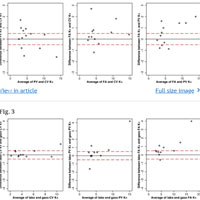Intra-patient Potassium Variability After Hypothermic Cardiac Arrest
sjtrem.biomedcentral.com
In a cohort of consecutive hypothermic cardiac arrest (CA) patients, we did not find an average difference in potassium concentration higher than 1 mmol/L between central and peripheral venous samples.
However, we found important and clinically significant variability in potassium values between central venous, peripheral venous and arterial sampling sites.
Our results suggest that the site of lowest potassium, and therefore the preferred site for a single potassium sampling is central venous blood.
Analysis of serial samplings from different sites may be an alternative, if clinically feasible.
Preanalytical considerations are important, to lower the risk of bias (falsely elevated potassium), which might signify, in the specific case of a hypothermic CA patient, the unjustified cessation of reanimation efforts.
Blood gas (BGA) is a fast and reliable tool that should be preferred to the CL in hypothermic CA.
The use of multivariable prediction tools like the HOPE score may help mitigate the risks inherent in the limits of potassium measurement.















